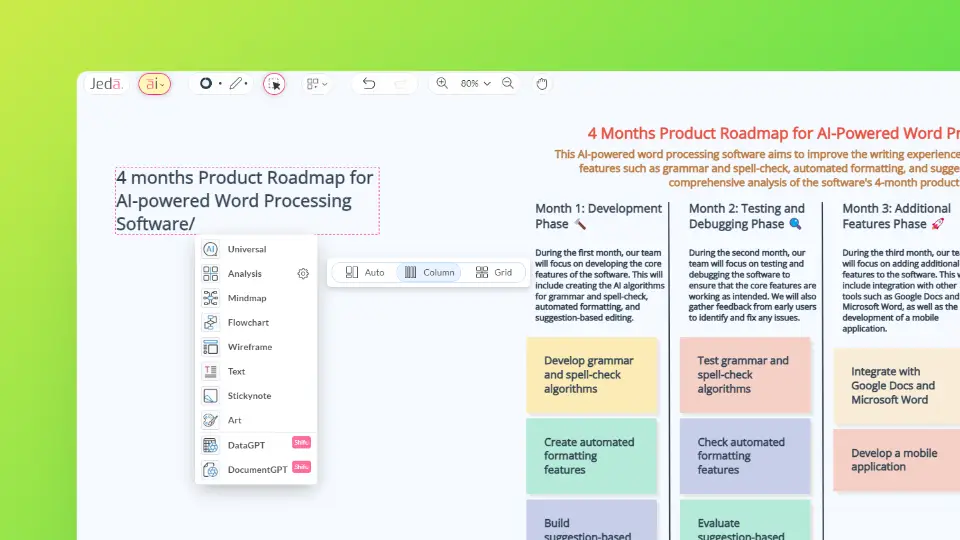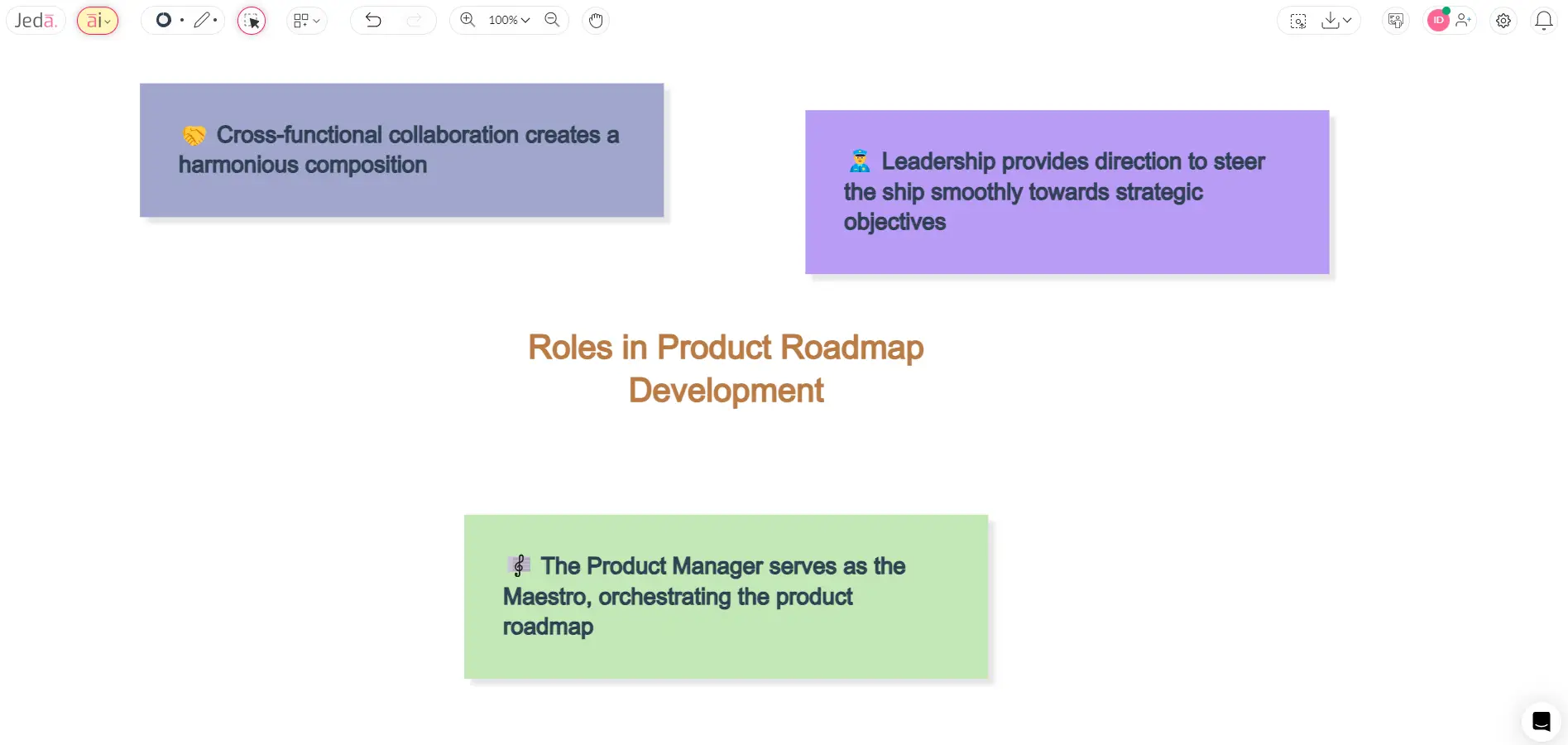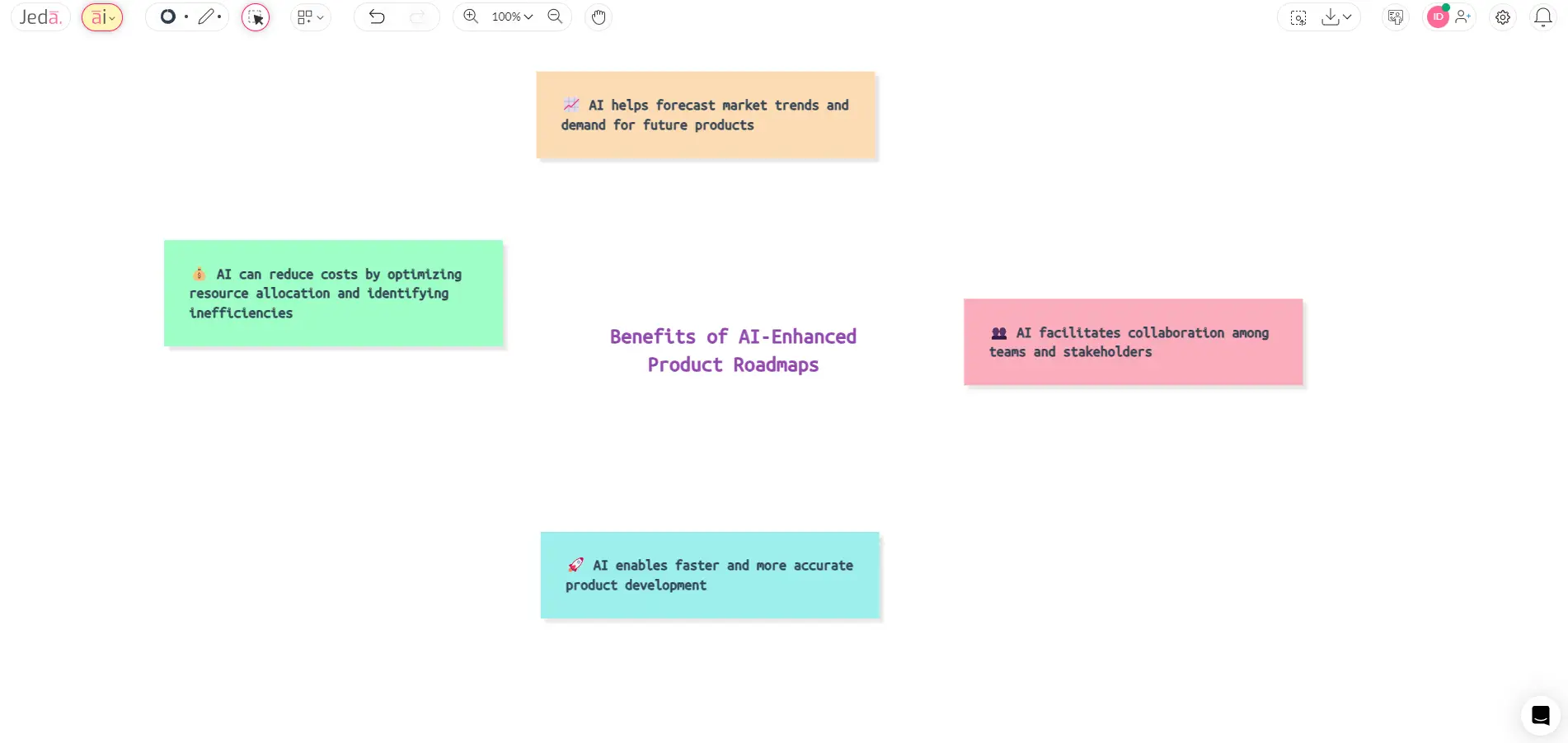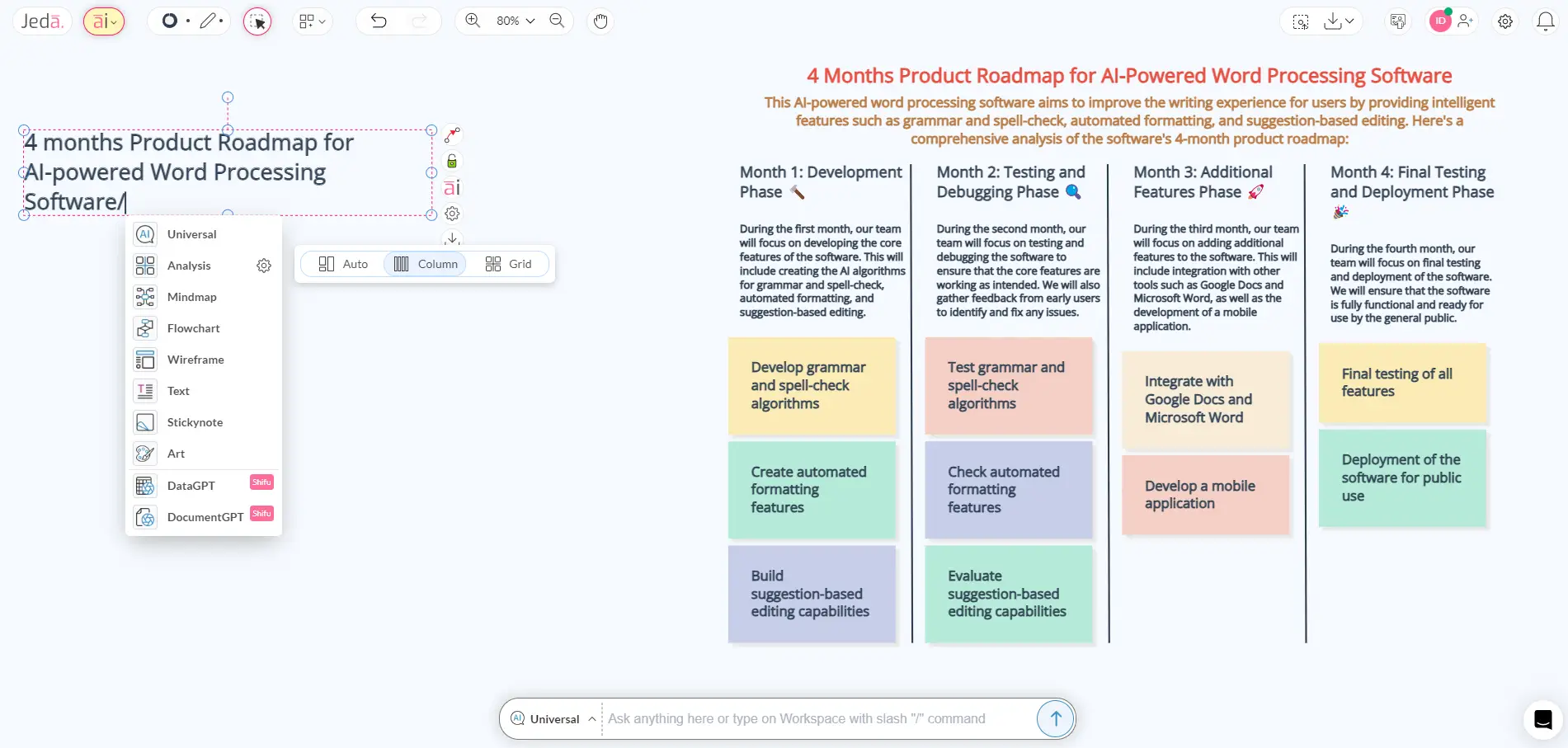
Generative AI Product Roadmaps — Jeda.ai's Generative AI Workspace
In the ever-evolving landscape of product development, the strategic use of Generative AI Product Roadmaps stand out as game-changer. Elevate your productivity.
April 8, 2024
Elevate Product Development with Jeda.ai - Generative AI Product Roadmaps for Boosting Your Strategy
Elevate your strategic planning with Generative AI Product Roadmaps. A product roadmap, akin to a dynamic GPS, navigates your development journey. It's not just a timeline; it's a compass, steering you through product strategy, development plans, and the intricate twists of your project timeline. Let's embark on this AI-enhanced journey together.

TL;DR:
👉 Generative AI Product Roadmaps revolutionize planning with strategic release planning, feature dependencies analysis, and dynamic timeline visualization.
👉 Leverage predictive analytics for precision, prioritize user-centric features, and integrate automated feedback for continuous improvement.
👉 Managing with AI enhances roadmap efficiency, smart forecasting, and data-driven decisions, maintaining adaptability in dynamic environments.
👉 Jeda.ai fosters seamless collaboration, boosting creativity and innovation in roadmap development.
Importance of Product Roadmaps
Crafting the Vision with Product Roadmaps
In the ever-evolving landscape of product management, a well-structured product roadmap acts as a compass, guiding teams through the dynamic journey of development. This crucial document not only outlines the path towards a product's destination but also serves as a strategic vision board for the entire team.
Example: Imagine you're planning a road trip. A roadmap, in this context, is your itinerary - a detailed plan that ensures you reach your destination efficiently, accounting for potential detours or scenic routes along the way.
Strategic Alignment and Cohesion
One of the key roles of a product roadmap is to align everyone within the organization to a common vision. It bridges the gap between different teams, ensuring that engineering, design, and marketing are all working in harmony towards shared goals.
Example: Picture a football team. Each player has a specific role and position, but a well-crafted playbook (or roadmap) ensures they move cohesively, working towards the common objective of scoring goals and winning the game.
Adaptability in the Face of Change
In the fast-paced tech landscape, change is inevitable. Product roadmaps, powered by AI, bring a dynamic element to planning. They can adapt in real-time to market shifts, user feedback, or unexpected challenges, ensuring your team remains agile and responsive.
Example: Think of a GPS app recalculating your route in real-time based on traffic updates. Similarly, AI in product roadmaps can reroute your development journey to avoid bottlenecks or capitalize on emerging opportunities.
Predictive Analytics: Anticipating Market Trends
The integration of AI introduces predictive analytics to product roadmaps. By analyzing historical data and market trends, AI can forecast future developments, allowing your team to proactively position your product in the market.
Example: Just as weather forecasts help you plan activities, AI-driven analytics predicts market conditions. If the forecast calls for increased demand in a certain feature, your product roadmap can navigate towards meeting that need.

Enhanced Collaboration with AI-Powered Tools
AI doesn’t replace human collaboration; it enhances it. AI-powered collaboration tools facilitate seamless communication among teams, making sure everyone is on the same page and fostering a culture of transparency.
Example: Think of a shared document where multiple contributors can edit in real-time. AI takes it a step further, suggesting improvements and ensuring the document evolves organically, much like a collaborative product roadmap.
Looking Ahead: Future Trends in AI-Powered Roadmapping
As technology advances, the synergy between AI and product roadmaps is poised to shape the future of product management. The incorporation of machine learning, natural language processing, and advanced analytics promises even more sophisticated and intuitive roadmaps.
Example: Just as smartphones evolved from basic phones to multifunctional devices, AI-powered roadmaps are evolving, offering product managers tools that can understand user sentiment, predict market shifts, and automate routine tasks.
Unlocking Success: Roles in Product Roadmap Development
In the orchestra of product development, the conductor of the roadmap is none other than the product manager. This key figure takes the lead in orchestrating the product roadmap, aligning diverse teams towards a common crescendo. Let's dive into the roles that shape this symphony of strategy.
1. The Maestro - Product Manager
The Product Manager, often referred to as the Maestro of product development, plays a pivotal role in orchestrating the intricate symphony of bringing a product to life. This skilled professional serves as the nexus between diverse teams, harmonizing engineering, design, marketing, and more. The Maestro's expertise lies not only in understanding market dynamics and user needs but also in crafting a strategic vision. In the realm of product management, their ability to navigate complexities, adapt to changes, and steer the team toward success is akin to the conductor leading an orchestra, shaping each note to create a product that resonates with its audience.
2. Harmony in Diversity - Cross-Functional Collaboration
Product roadmaps thrive on the synergy of cross-functional collaboration. Engineers, marketers, and designers contribute unique melodies to the composition. AI acts as the universal language, breaking down barriers and enhancing communication. Through this collaboration, the roadmap becomes a collective masterpiece, each department contributing to the harmonious progression of the product.

3. Leadership: The Baton of Direction
Leadership isn't just about steering the ship; it's about charting the course. In product roadmap development, leadership ensures that the ship sails smoothly towards strategic objectives. AI augments this leadership by providing real-time data, transforming the captain's decisions into a well-informed voyage.
With Generate AI Product Roadmaps, witness a seamless collaboration orchestrated by the product manager, fueled by cross-functional harmony, and directed by leadership. The result? A roadmap that isn't just a plan but a dynamic symphony, resonating with the market's pulse and poised for success.
Users of Product Roadmaps
In the realm of product development, the question isn't just "Who uses a product roadmap?" but rather, "Who doesn't?" Let's break it down to understand how various stakeholders find value in this dynamic tool.
1. Stakeholders: Navigating the Vision
Stakeholders, including investors, board members, and external partners, often seek assurance and clarity regarding the product's trajectory. A well-crafted product roadmap, generated with the prowess of AI, becomes a visual testament, aligning their expectations with the strategic vision. This not only fosters trust but also allows them to actively participate in decision-making processes.
2. Executives: Aligning Strategy with Execution
For executives steering the ship, a product roadmap serves as a compass. AI-integrated roadmaps provide them with real-time insights, enabling swift adjustments to align with market dynamics. The synergy between strategic planning and AI insights ensures that executives not only set the course but can also make informed, timely decisions to stay on track.

3. Development Teams: Guiding the Execution
Development teams, the heartbeat of product realization, thrive on clarity and direction. AI's role here is pivotal, as it helps anticipate potential roadblocks and streamline the development process. From prioritizing features to understanding dependencies, a product roadmap powered by AI becomes an invaluable guide for development teams, ensuring efficient and focused execution.
The AI Advantage
Imagine a scenario where stakeholders, executives, and development teams seamlessly collaborate and navigate through a roadmap that evolves as dynamically as the industry itself. AI brings this vision to life, ensuring that the product roadmap isn't just a static document but a living, breathing guide that responds to real-time data and market shifts.
The synergy between stakeholders envisioning the future, executives strategizing the path, and development teams executing with precision forms the cornerstone of successful product development. In this collaborative dance, AI is the silent choreographer, orchestrating a symphony of innovation and strategic alignment. The question is not just who uses a product roadmap but how AI transforms it into a shared vision that propels businesses into the future.
Planning the Product Roadmap
Embarking on the journey to generate a product roadmap with AI involves a thoughtful approach to planning. Here’s a breakdown of key steps and techniques to ensure your roadmap is not just a chart but a strategic blueprint:
➡️ Prioritization Techniques: Prioritizing features is a critical step in roadmap planning. Leverage AI algorithms to analyze historical data, customer feedback, and market trends. This ensures that your prioritization is not just based on gut feelings but is rooted in data-driven insights.
➡️ Feature Selection with AI Precision: AI brings a new level of precision to feature selection. Instead of relying solely on manual assessments, machine learning algorithms can identify patterns and correlations within your data, aiding in the selection of features that align seamlessly with your product's trajectory.
➡️ Market Analysis for Informed Decisions: A comprehensive market analysis is fundamental to effective roadmap planning. AI tools can sift through vast amounts of market data, identifying emerging trends, competitive landscapes, and potential opportunities. This ensures your roadmap is not just internally focused but finely tuned to external market dynamics.

➡️ Navigating Prioritization Challenges: While prioritization is crucial, it can be a challenging balancing act. AI comes to the rescue by providing a nuanced understanding of user preferences, helping you strike the right balance between customer needs, technological feasibility, and business objectives.
AI-Enhanced Prioritization in Action
Imagine a scenario where traditional prioritization might overlook a crucial feature. AI, analyzing user behavior and market trends, identifies this feature's potential impact, ensuring it takes precedence in your roadmap. This not only improves customer satisfaction but also positions your product strategically in the market.
When you generate a product roadmap with AI, the planning phase becomes an insightful and dynamic process. Prioritization, feature selection, and market analysis, when powered by AI, elevate your roadmap from a static plan to a living document that responds to the ever-evolving landscape of your industry.
Generative AI Product Roadmaps: Unlocking Key Components for Success
Creating a robust product roadmap is pivotal for any business, and leveraging AI can supercharge this process, ensuring it becomes a dynamic and adaptive tool for success. Let's delve into the key components that make a product roadmap comprehensive and effective.
1. Strategic Release Planning: Incorporate AI to strategically plan releases, ensuring that each product launch aligns seamlessly with your business objectives. AI-driven insights can help identify optimal release timelines, ensuring your offerings hit the market when demand is at its peak.
2. Feature Dependencies Analysis: AI excels at analyzing intricate feature dependencies, providing a deeper understanding of how each element contributes to the overall product. By leveraging AI, you can identify dependencies early, allowing for smoother development cycles and preventing bottlenecks.
3. Dynamic Timeline Visualization: With AI, your roadmap transforms into a dynamic, living document. Visualize timelines that adapt to real-time changes, keeping your team informed and enabling quick adjustments to meet evolving market needs. This visualization ensures a clear overview of your product's journey.

4. Predictive Analytics for Roadmap Precision: Harness the power of predictive analytics through AI to enhance the precision of your roadmap. Anticipate potential roadblocks, identify trends, and adjust your roadmap proactively based on data-driven insights, ensuring a more accurate alignment with market demands.
5. User-Centric Feature Prioritization: AI algorithms can analyze user data to understand preferences, enabling you to prioritize features that resonate most with your audience. This user-centric approach ensures that your roadmap reflects the features that truly matter to your customers.
6. Automated Feedback Integration: Integrate AI-driven tools to automate the feedback loop. Gather user feedback systematically and analyze it to refine your roadmap continuously. This iterative process, powered by AI, keeps your roadmap in sync with user expectations and market trends.
By incorporating these key components, your product roadmap transforms into a dynamic, AI-infused guide that not only navigates your development journey but does so with strategic foresight and adaptability, driving success for your business.
Managing the Product Roadmap
Embarking on the journey to generate a product roadmap with AI revolutionizes the way we approach planning and execution. Once your roadmap is in place, the next crucial step is adept management. How to Manage a Product Roadmap involves a delicate balance of updates, revisions, and agile adaptation. Swiftly responding to evolving market dynamics and user feedback becomes second nature
👉 Updates and Revisions: In the dynamic realm of product development, regular updates and revisions are the heartbeat of a well-managed roadmap. AI lends a helping hand by swiftly processing data, enabling teams to incorporate changes seamlessly. This agility ensures that your roadmap stays not just relevant but ahead of the curve.
👉 Agile Adaptation: The heartbeat of modern product management is the agile methodology. Managing a product roadmap involves constant adaptation. With AI, the process becomes intelligent, allowing for rapid adjustments based on real-time insights and shifting priorities.
👉 Tracking Progress: The key to successful roadmap management lies in effectively tracking progress. AI-enhanced tools provide a bird’s eye view, allowing teams to monitor milestones, identify bottlenecks, and celebrate achievements. This streamlined approach ensures that your product roadmap isn’t just a plan but a living, breathing guide for your team's success.

Benefits of AI-Enhanced Product Roadmaps
➡️ Unleashing Efficiency through AI: Generate product roadmaps with AI for unparalleled efficiency. Artificial Intelligence propels your roadmap planning by automating tedious tasks, allowing your team to focus on strategic decision-making. With predictive analytics, AI identifies patterns and predicts potential roadblocks, streamlining the planning process.
➡️ Precision with Smart Forecasting: AI introduces a level of precision to your roadmap that goes beyond traditional methods. Smart forecasting, powered by AI algorithms, analyzes historical data and market trends to provide accurate insights into future demands. This foresight ensures that your roadmap isn't just a plan; it's a well-calibrated projection, reducing uncertainties and enhancing decision-making.
➡️ Data-Driven Decision Making: In the era of information, making decisions without leveraging data is like navigating a ship without a compass. AI-enhanced product roadmaps prioritize data-driven decisions. The algorithms sift through vast datasets, offering actionable insights that enable you to make informed choices. This not only mitigates risks but also positions your roadmap as a strategic compass aligning with market dynamics.
➡️ Adaptive Roadmaps for Dynamic Environments: One of the standout benefits of incorporating AI is the adaptability it brings to your product roadmap. In dynamic business environments, where change is the only constant, an AI-infused roadmap adjusts in real-time. It learns from evolving data, making it a living document that evolves with your business, ensuring that your plans are always current and relevant.
➡️ Seamless Integration for Enhanced Collaboration: AI doesn't replace human collaboration; it enhances it. By generating product roadmaps with AI, you create a collaborative ecosystem where human insights are complemented by AI-driven analysis. This synergy fosters a culture of innovation, where your team's creativity is amplified by the precision and efficiency of AI algorithms.

Future Trends in AI-Powered Product Roadmaps
The landscape of product roadmap planning is evolving with the infusion of Artificial Intelligence (AI). As we dive into the future, emerging technologies are reshaping how businesses strategize and execute their product development journeys. Advanced analytics, predictive modeling, and continuous improvement stand at the forefront of this revolution.
👉 Advanced Analytics Unleashed: AI-powered product roadmaps leverage advanced analytics to decipher vast datasets swiftly. This goes beyond traditional methods, enabling a deep dive into user behavior, market trends, and competitor landscapes. Through this lens, businesses gain valuable insights that drive strategic decision-making, allowing for a more nuanced and informed roadmap.
👉 Predictive Modeling for Precision: The integration of predictive modeling in roadmap generation catapults planning to a new echelon. By forecasting future trends and potential challenges, businesses can proactively structure their product roadmaps. This not only streamlines the development process but also enhances adaptability, ensuring that the roadmap remains agile and responsive to market dynamics.
👉 Continuous Improvement as a Standard: AI doesn't just stop at initial roadmap creation; it thrives in the realm of continuous improvement. With machine learning algorithms, product roadmaps become dynamic entities, evolving in real-time as new data flows in. This adaptability is a game-changer, allowing businesses to stay ahead in a rapidly changing market by adjusting strategies on the fly.
In essence, generating product roadmaps with AI doesn't just signify a technological leap; it marks a paradigm shift in how businesses navigate their growth journey. The infusion of advanced analytics and predictive modeling, coupled with a commitment to continuous improvement, positions AI as a cornerstone in shaping the future of product development. As businesses embrace these trends, they unlock a competitive edge that propels them into the next era of innovation and success.
Why Use Jeda.ai for Generating Product Roadmaps with AI?
Using Jeda.ai for generating product roadmaps with AI offers a myriad of benefits that cater to the dynamic needs of modern business planning and strategy. It revolutionizes the way teams collaborate on product development, from initial ideation to strategic launch plans. Here are reasons why Jeda.ai stands out for generating product roadmaps:
Generative AI Technology
Jeda.ai is at the forefront with its Generative AI capabilities, making it easier to visualize complex ideas through flowcharts, diagrams, wireframes, and more. This feature significantly enhances the planning stage of product roadmaps by allowing more intuitive and detailed representations of product strategies.
Dynamic Collaboration
The AI Online Whiteboard fosters a collaborative environment where team members can contribute in real-time. Its user-friendly interface encourages creativity and ensures that every member’s ideas are visualized, discussed, and integrated seamlessly into the roadmap.
Efficient Ideation and Brainstorming
With tools like the AI Visual Chat, teams can rapidly prototype ideas directly on the whiteboard without switching between different applications. This streamlines the brainstorming process, making it more productive and focused on generating actionable outcomes.

Visual Analysis and Template Generator
Whether it's conducting a SWOT analysis or planning a blue ocean strategy, Jeda.ai's Visual Analysis & Template Generator helps teams to formulate compelling strategies quickly. It aids in creating engaging business visuals that are critical for a well-defined product roadmap.
Customizable Diagrams and Art Generation
The AI Diagram and Art & Content Generators allow for the creation of custom visuals that can represent different aspects of the product roadmap. Be it organizational diagrams or infographics, Jeda.ai enables personalization to fit the unique requirements of your product strategy.
AI Wireframe Generator
For products that require a digital interface, the AI Wireframe Generator is an invaluable tool. It aids in the quick design of initial wireframes, transforming abstract concepts into tangible prototypes that can be further refined in the product roadmap.
DataGPT and Document Analysis
For evidence-based planning, Jeda.ai offers DataGPT for Strategic Data Analysis and DocumentGPT for Document Analysis. These features provide interactive charts and visualizations from complex data, ensuring that decision-making is backed by solid insights.
By leveraging Jeda.ai for your product roadmaps, you tap into a powerful, AI-enhanced toolset that streamlines the planning process, facilitates deeper collaboration, and enables smarter, data-driven strategic decisions. Whether you're in the early stages of ideation or refining your go-to-market strategy, Jeda.ai provides a comprehensive, efficient, and secure platform to bring your product vision to life.
How to Use Jeda.ai for Generative AI Product Roadmaps?
Generative AI Product Roadmaps with AI Recipes on Jeda.ai's Generative AI Workspace

🪄 Log in to Jeda.ai and enter a workspace of your choice.
🪄 Navigate to the AI Menu located at the top right corner. Under Product, select the option for Product Roadmap.
🪄 Respond to a few intuitive questions related to your business or project.
🪄 Choose your preferred layout.
🪄Hit “Generate”.
Generative AI Product Roadmaps with AI Slash Commands on Jeda.ai's Generative AI Workspace

🪄 After logging in, enter your Workspace of choice.
🪄 On the AI Online Whiteboard, type the query about your desired product development roadmap. For example, you might want to try: "4 months product roadmap for AI-powered Word Processing software".
🪄 Simply put a forward slash (/) after your query, and a list of available AI commands will appear. Select "Analysis" and choose your preferred layout option to initiate the AI-powered product roadmap generation process.
Generative AI Product Roadmaps with AI Command Bar on Jeda.ai's Generative AI Online Whiteboard

➡️ Sign in and select your desired Workspace.
➡️ Towards the bottom of your Workspace, you'll see the AI Command Bar. Click on it and select the "Analysis" command. Then type in your required query about the product roadmap strategy.
➡️ You may kickstart your brainstorming process with a wealth of prepopulated dynamic prompts provided by the AI.
➡️ Whether you are using a dynamic prompt or creating your unique one, you'll notice a DP button next to your query. This button offers granular tuning options to customize your prompt further.
➡️ When you're satisfied with your prompts and parameters, all you have to do is choose a preferred layout and hit the "Generate" button.
Conclusion
In the ever-evolving landscape of product development, the strategic use of AI in generating product roadmaps stands out as a game-changer. As we've explored the intricacies of roadmap creation, it's evident that AI brings unparalleled efficiency, accuracy, and adaptability to the table. Leveraging advanced analytics and predictive modeling, AI not only automates the planning process but also empowers teams to make data-driven decisions with confidence.
As we look ahead, the future promises even more exciting possibilities. The integration of emerging technologies like continuous improvement algorithms and smart forecasting holds the potential to reshape how teams envision, plan, and execute their product roadmaps. Embracing this technological wave is not just an option; it's a strategic necessity for staying competitive in today's dynamic markets. So, whether you're a seasoned product manager or navigating the entrepreneurial landscape, one thing is clear—Generative AI Product Roadmaps are your best friend in the creative journey. It's not just a trend; it's a transformation.




%202.svg)